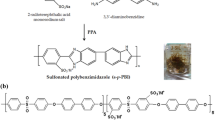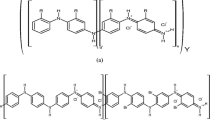Abstract
N1-alkyl (octyl and dodecyl)-substituted imidazolium-based PVBC homopolymers have been synthesized via N-quaternization reaction of N1-alkyl imidazole and PVBC precursor homopolymer bearing reactive benzyl chloride moieties. Due to their poor film forming properties and water solubility, these homopolymers were blended with aromatic polyethers bearing main chain pyridine units at different compositions in order to study the effect of alkyl chain length on morphology, water uptake, swelling ability and chemical stability of the prepared membranes. The B2 blend membrane with the highest N1-dodecyl-substituted imidazolium PVBC content (65 wt%) exhibited the highest water uptake (54%) despite its lower IEC value compared to the corresponding one containing N1-octyl-substituted imidazolium PVBC, low swelling ratio and a phase separated morphology. Evaluation of the chemical stability in 3.6 M KOH solution at 80 °C for 7 days revealed the degradation of imidazolium via ring opening, as evidenced by ATR-FT-IR spectroscopy. Therefore, new blends having as second constituent, the N1-alkyl-substituted imidazolium functionalized poly(PVBC-co-AA20) copolymers containing acrylic acid units were fabricated targeting to the improvement of chemical stability via ionic cross linking. The prepared D1 and D2 blend membranes containing 60 and 65 wt% dodecyl-imidazolium functionalized poly(PVBC-co-AA20) copolymer content, respectively, were flexible, exhibited moderate IECs (1.47–1.60 meq/g) and sufficient water uptakes (up to 30%). D2 blend membrane showed excellent chemical stability after testing in 3.6 M KOH solution at 80 °C for 30 days, as confirmed by ATR-FT-IR spectroscopy and TGA analysis. The excellent chemical stability can probably be attributed to the steric hindrance effect of N1 dodecyl substituent which effectively protects the C2 position of imidazolium from hydroxide attack as well as to the formation of a dense, ionic cross-linked structure that hinders hydroxide penetration.










Similar content being viewed by others
References
Varcoe JR, Atanassov P, Dekel DR, Herring AM, Hickner MA, Kohl PA, Kucernak AR, Mustain WE, Nijmeijer K, Scott K, Xu T, Zhuang L (2014) Anion-exchange membranes in electrochemical energy systems. Energy Environ Sci 7:3135–3191
Pan ZF, An L, Zhao TS, Tang ZK (2018) Advances and challenges in alkaline anion exchange membrane fuel cells. Prog Energy Combust Sci 66:141–175
Arges CG, Zhang L (2018) Anion exchange membranes evolution towards high hydroxide ion conductivity and alkaline resiliency. ACS Appl Energy Mater 1:2991–3012
Marino MG, Kreuer KD (2015) Alkaline stability of quaternary ammonium cations for alkaline fuel cell membranes and ionic liquids. ChemSusChem 8:513–523
Sun Z, Lin B, Yan F (2018) Anion-exchange membranes for alkaline fuel-cell applications: the effect of cations. Chemsuschem 11:58–70
Long H, Kim K, Pivovar BS (2012) Hydroxide degradation pathways for substituted trimethylammonium cations: a DFT study. J Phys Chem C 116:9419–9426
Dang H-S, Jannasch P (2017) A comparative study of anion exchange membranes tethered with different hetero-cycloaliphatic quaternary ammonium hydroxides. J Mater Chem A 5:21965–21978
Al Munsur AZ, Hossain I, Nam SY, Eon Chae J, Kim T-H (2020) Hydrophobic-hydrophilic comb-type quaternary ammonium-functionalized SEBS copolymers for high performance anion exchange membranes. J Membr Sci 599:117829
Xue J, Liu X, Zhang J, Yin Y, Guiver MD (2020) Poly(phenylene oxide)s incorporating N-spirocyclic quaternary ammonium cation/cation strings for anion exchange membranes. J Membr Sci 595:117507
Lee KH, Cho DH, Kim YM, Moon SJ, Seong JG, Shin DW, Sohn J-Y, Kim JF, Lee YM (2017) Highly conductive and durable poly(arylene ether sulfone) anion exchange membrane with end-group cross-linking. Energy Environ Sci 10:275–285
Lim H, Lee B, Dayoung Y, Al Munsur AZ, Chae J-E, Lee SY, Kim S-J, Nam SY, Park CH, Kim T-H (2018) Poly(2,6-dimethyl-1,4-phenylene oxide)s with various head groups: effect of head groups on the properties of anion exchange membranes. ACS Appl Mater Interfaces 10(48):41279–41292
Yang C, Wang S, Ma W, Jiang L, Sun G (2015) Highly alkaline stable N1-alkyl substituted 2-methylimidazolium functionalized alkaline anion exchange membranes. J Mater Chem A 3:8559–8565
Zhu Y, He Y, Ge X, Liang X, Shehzad MA, Hu M, Liu Y, Wu L, Xu T (2018) A benzyltetramethylimidazolium-based membrane with exceptional alkaline stability in fuel cells: role of its structure in alkaline stability. J Mater Chem A 6:527–534
Lin X, Wu L, Liu Y, Ong AL, Poynton SD, Varcoe JR, Xu T (2012) Alkali resistant and conductive guanidinium-based anion-exchange membranes for alkaline polymer electrolyte fuel cells. J Power Sources 217:373–380
Vöge A, Deimede V, Kallitsis JK (2014) Synthesis and properties of alkaline stable pyridinium containing anion exchange membranes. RSC Adv 4(85):45040–45049
Noonan KJT, Hugar KM, Kostalik HA, Lobkovsky EB, Abruña HD, Coates GW (2012) Phosphonium-functionalized polyethylene: a new class of base-stable alkaline anion exchange membranes. J Am Chem Soc 134(44):18161–18164
Papakonstantinou P, Deimede V (2016) Self-cross-linked quaternary phosphonium based anion exchange membranes: assessing the influence of quaternary phosphonium groups on alkaline stability. RSC Adv 6(115):114329–114343
Wang J, Wang X, Zu D, Hua Y, Li Y, Yang S, Wei H, Ding Y (2018) N3-adamantyl imidazolium cations: alkaline stability assessment and the corresponding comb-shaped anion exchange membranes. J Membr Sci 545:116–125
Ye Y, Elabd YA (2011) Relative chemical stability of imidazolium-based alkaline anion exchange polymerized ionic liquids. Macromolecules 44:8494–8503
Si Z, Sun Z, Gu F, Qiu L, Yan F (2014) Alkaline stable imidazolium-based ionomers containing poly(arylene ether sulfone) side chains for alkaline anion exchange membranes. J Mater Chem A 2:4413–4421
Fan J, Wright AG, Britton B, Weissbach T, Skalski TJG, Ward J, Peckham TJ, Holdcroft S (2017) Cationic polyelectrolytes stable in 10 M KOHaq at 100 °C. ACS Macro Lett 6:1089–1093
You W, Hugar KM, Coates GW (2018) Synthesis of alkaline anion exchange membranes with chemically stable imidazolium cations: unexpected cross-linked macrocycles from ring-fused ROMP monomers. Macromolecules 51:3212–3218
Hugar KM, Kostalik HA IV, Coates GW (2015) Imidazolium cations with exceptional alkaline stability: a systematic study of structure-stability relationships. J Am Chem Soc 137:8730–8737
Gu F, Dong H, Li Y, Si Z, Yan F (2014) Highly stable N3-substituted imidazolium-based alkaline anion exchange membranes: experimental studies and theoretical calculations. Macromolecules 47:208–216
Yang J, Liu C, Hao Y, He X, He R (2016) Preparation and investigation of various imidazolium-functionalized poly(2,6-dimethyl-1,4-phenylene oxide) anion exchange membranes. Electrochim Acta 207:112–119
Diesendruck CE, Dekel DR (2018) Water–a key parameter in the stability of anion exchange membrane fuel cells. Curr Opin Electrochem 9:1–6
Dekel DR, Amar M, Willdorf S, Kosa M, Dhara S, Diesendruck C (2017) Effect of water on the stability of quaternary ammonium groups for anion exchange membrane fuel cell applications. Chem Mater 29:4425–4431
Zhang N, Huo J, Yang B, Ruan X, Zhang X, Bao J, Qi W, He G (2018) Understanding of imidazolium group hydration and polymer structure for hydroxide anion conduction in hydrated imidazolium-g-PPO membrane by molecular dynamics simulations. Chem Eng Sci 192:1167–1176
Kerres JA, Krieg HM (2017) Poly(vinylbenzylchloride) based anion-exchange blend membranes (AEBMs): influence of PEG additive on conductivity and stability. Membranes 7:32
Lu W, Shao Z-G, Zhang G, Zhao Y, Yi B (2014) Crosslinked poly(vinylbenzyl chloride) with a macromolecular crosslinker for anion exchange membrane fuel cells. J Power Sources 248:905–914
Geormezi M, Deimede V, Kallitsis JK, Neophytides S (2012) Polymer blends based on copolymers bearing both side and main chain pyridine units as proton exchange membranes for high temperature fuel cells. J Membr Sci 396:57–66
Voege A, Deimede V, Kallitsis JK (2012) Side chain crosslinking of aromatic polyethers for high temperature polymer electrolyte membrane fuel cell applications. J Polym Sci Part A Polym Chem 50:207–216
Pefkianakis EK, Deimede V, Daletou MK, Gourdoupi N, Kallitsis JK (2005) Novel polymer electrolyte membrane based on pyridine containing poly(ether sulfone) for application in high-temperature fuel cells. Macromol Rapid Commun 26:1724–1728
Vöge A, Deimede V, Paloukis F, Neophytides SG, Kallitsis JK (2014) Synthesis and properties of aromatic polyethers containing poly (ethylene oxide) side chains as polymer electrolytes for lithium ion batteries. Mater Chem Phys 148(1–2):57–66
Deimede V, Voege A, Lainioti G, Elmasides C, Kallitsis JK (2014) Large-scale separators based on blends of aromatic polyethers with PEO for li-ion batteries: improving thermal shrinkage and wettability behavior. Energy Technol 2:275–283
Vollas A, Chouliaras Th, Deimede V, Ioannides Th, Kallitsis JK (2018) New pyridinium type Poly(ionic liquids) as membranes for CO2 separation. Polymers 10(8):912
Chouliaras Th, Vollas A, Ioannides Th, Deimede V, Kallitsis JK (2019) Synthesis of imidazolium based PILs and investigation of their blend membranes for gas separation. Membranes 9(12):164
Deimede V, Vroulias D, Kallitsis J, Ioannides T (2020) Pyridinium based Poly (Ionic Liquids) membranes with exceptional high water vapor permeability and selectivity. Sep Pur Technol 251:117412
Kougia E, Tselepi M, Vasilopoulos G, Lainioti G, Koromilas ND, Druvari D, Bokias G, Vantarakis A, Kallitsis JK (2015) Evaluation of antimicrobial efficiency of new polymers comprised by covalently attached and/or electrostatically bound bacteriostatic species, based on quaternary ammonium compounds. Molecules 20:21313–21327
Druvari D, Koromilas ND, Lainioti G, Bokias G, Vasilopoulos G, Baras I, Dourala N, Kallitsis JK (2016) Polymeric quaternary ammonium-containing coatings with potential dual contact-based and release-based antimicrobial activity. ACS Appl Mater Interfaces 8:35593–35605
Zhang Q-G, Wang N-N, Wang S-L, Yu Z-W (2011) Hydrogen bonding behaviors of binary systems containing the ionic liquid 1-butyl-3-methylimidazolium Trifluoroacetate and water/methanol. J Phys Chem B 115:11127–11136
Cha S, Ao M, Sung W, Moon B, Ahlstrom B, Johansson P, Ouchi Y, Kim D (2014) Structure of ionic liquid/water mixtures investigated by IR and NMR spectroscopy. Phys Chem Chem Phys 16:9591–9601
Fumino K, Wulf A, Ludwig R (2008) Strong, localized and directional hydrogen bonds fluidize ionic liquids. Angew Chem Int Ed 47:8731–8734
Hunt PA, Ashworth CR, Matthews RP (2015) Hydrogen bonding in ionic liquids. Chem Soc Rev 44:1257–1288
Chang H-C, Jiang J-C, Tsai W-C, Chen G-C, Lin SH (2006) Hydrogen bond stabilization in 1,3-dimethylimidazolium methyl sulfate and 1-butyl-3-methylimidazolium hexafluorophosphate probed by high pressure: the role of charge-enhanced C−H···O interactions in the room-temperature ionic liquid. J Phys Chem B 110:3302–3307
Yokozeki A, Kasprzak DJ, Shiflett MB (2007) Thermal effect on C-H stretching vibrations of the imidazolium ring in ionic liquids. Phys Chem Chem Phys 9(36):5018–5026
Donato RK, Lavorgna M, Musto P, Donato KZ, Jager A, Stӗpánek P, Schrekker HS, Matӗjka L (2015) The role of ether-functionalized ionic liquids in the sol-gel process: effect on the initial alkoxide hydrolysis steps. J Colloid Interface Sci 447:77–84
Rao AHN, Thankamony RL, Kim H-J, Nam S, Kim T-H (2013) Imidazolium-functionalized poly(arylene ether sulfone) block copolymer as an anion exchange membrane for alkaline fuel cell. Polymer 54:111–119
Lafitte G, Espuche E, Gérard J-F (2011) Polyamide 11/poly(hydroxyl amino ether) blends: influence of the blend composition and morphology on the barrier and mechanical properties. Eur Polym J 47:1994–2002
Holloczki O, Terleczsky P, Szieberth D, Mourgas G, Gugat D, Nyulaski L (2011) Hydrolysis of Imidazole-2-ylidenes. J Am Chem Soc 133:780–789
Muir M, Molina DL, Islam A, Abdel-Rahman M, Trenary M (2020) Adsorption properties of acrolein, propanal, propenol and 1-propanol on Ag(111). Phys Chem Chem Phys 22:25011–25020
Hameed N, Guo Q (2009) Self-assembled complexes of poly(acrylic acid) and poly(styrene)-block-poly(4-vinyl pyridine). J Polym Sci Part B Polym Phys 47:1192–1202
Li B, Lu X, Ma Y, Chen Z (2014) Thermo- and pH-responsive behaviors of aqueous poly(acrylic acid)/poly(4-vinylpyridine) complex material characterized by ATR-FTIR and UV–Vis Spectroscopy. Eur Polym J 60:255–261
Oyama HT, Nakajima T (1983) Structure and sorption properties of the polyion complex between poly(acrylic acid) and poly(4-vinylpyridine). J Polym Sci Polym Chem 21:2987–2995
Guo D, Zhuo YZ, Lai AN, Zhang QG, Zhu AM, Liu QL (2016) Interpenetrating anion exchange membranes using poly(1-vinyl imidazole) as bifunctional crosslinker for fuel cells. J Membr Sci 518:295–304
Acknowledgements
This study was financially supported by Greece and the European Union (European Social Fund- ESF) through the Operational Programme «Human Resources Development, Education and Lifelong Learning» in the context of the project “Strengthening Human Resources Research Potential via Doctorate Research” (MIS-5000432), implemented by the State Scholarships Foundation (ΙΚΥ).
Author information
Authors and Affiliations
Corresponding author
Additional information
Publisher's Note
Springer Nature remains neutral with regard to jurisdictional claims in published maps and institutional affiliations.
Supplementary Information
Below is the link to the electronic supplementary material.
Rights and permissions
About this article
Cite this article
Tsagdi, A., Dimitriou, M., Druvari, D. et al. Blend membranes based on N1-alkyl-substituted imidazolium functionalized polymers and aromatic polyethers: influence of N1-alkyl substituent on properties and alkaline stability. Polym. Bull. 79, 1647–1668 (2022). https://doi.org/10.1007/s00289-021-03581-5
Received:
Revised:
Accepted:
Published:
Issue Date:
DOI: https://doi.org/10.1007/s00289-021-03581-5




